
- To receive an antibiotic intravenously, the equipment required includes:
- a catheter (thin flexible tube) is installed through the skin and inside a vein to allow the drug to enter the bloodstream;
- the catheter is attached to tubing (small flexible plastic tube on the outside of the skin) which has a clamp and a needleless connector (or injection cap); this connector is usually attached to longer tubing called the extension tube;
- a transparent dressing protects the insertion site of the catheter, where the catheter enters the skin;
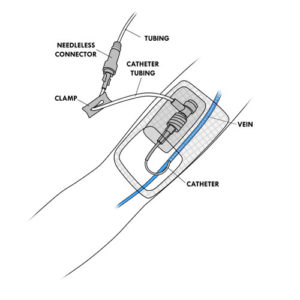

-
- an elastomeric infusion pump, bag or cassette reservoir contains the antibiotic;
- the bag or cassette reservoir is connected to an ambulatory infusion pump (eg, CADD-Legacy® PLUS, CADD-Prizm® VIP or CADD®-Solis VIP) via tubing;
- the flow rate of the antibiotic is programmed and controlled by the pump.
- The choice of the type of catheter depends on the duration of the treatment, the age of the child, the health condition and the condition of the veins.
Several kinds of catheters exist:
- Short peripheral catheter: short thin tube about 1 to 4 cm inserted into a small vein (eg, in the hand or the forearm). This type of catheter is useful for short term IV therapies.
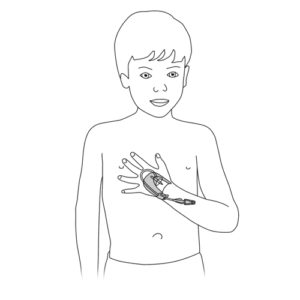
-
- Peripherally inserted cental catheter (commonly referred to as “PICC line”): long thin tube inserted in a larger vein of an arm and which follows its path to the entrance of the heart. This type of catheter is useful when IV therapy is required for more than a week.

-
- Central tunnel catheter (eg, Broviac®): this type of catheter is inserted partly under the skin of the chest and is threaded through a larger vein towards the heart. This type of catheter is useful when longer term IV therapies are needed.
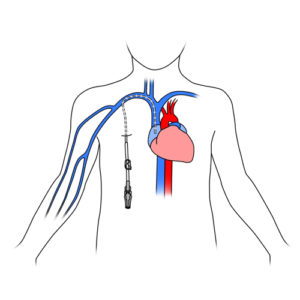
-
- Implantable chamber catheter (eg, Port-a-cath®): includes a small reservoir inserted under the skin and attached to a catheter which is inside a large vein leading to the heart. The reservoir is accessed by piercing the skin with a special noncoring needle (eg, Huber needle). This type of catheter is useful when long term IV access is required.
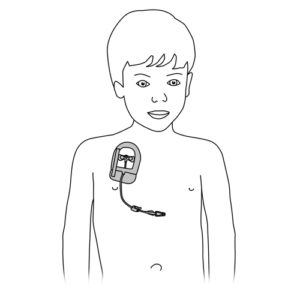
- Several types of infusion systems can be used to administer intravenous antibiotics:
- Elastomeric infusion pump or portable infusion pump (eg, Intermate infusion pump): a plastic case contains an elastic balloon-shaped reservoir that inflates when filled with the prescribed amount of antibiotic.
This balloon exerts a gradual pressure on the medication which can thus flow into the tubing then into the catheter and the vein.
A flow controller limits the speed of medication release from the pump.
Each elastomeric infusion pump contains a single dose of medication.
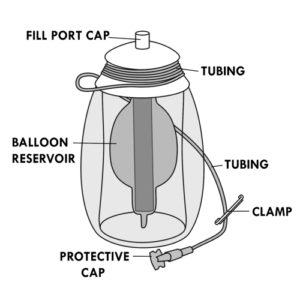
- Ambulatory infusion pump: the antibiotic is contained in a reservoir, in sufficient quantity for the day.
If this reservoir is a bag, then the bag tubing is connected to a tubing with cassette which is connected to the pump. The tubing of the cassette is connected to that of the catheter, with or without extension tube.
If this reservoir is a cassette reservoir, it is directly connected to the pump and the cassette reservoir tubing connects to the catheter tubing, with or without an extension tube.
Some models of ambulatory infusion pumps have an air detector for their tubing and a lock to secure the cassette or cassette reservoir to it.


The pump works with non-rechargeable batteries or a rechargeable battery (depending on model) and is light enough to be worn all day by most children (usually in a small backpack).
It is programmed to automatically deliver the antibiotic into your child’s catheter at the times prescribed by the doctor.
Outside these periods, a very small amount of medication is administered by the pump to prevent the vein from blocking. Your child stays connected to the pump.
A CADD brand pump is commonly used in children, especially the Legacy®PLUS, Prizm ®VIP or ®Solis VIP models. The CADD-Legacy® PLUS pump was chosen to illustrate the steps of the care shown here.
Your child’s healthcare team will supervise the IV treatment and ensure that the equipment is functioning properly. Ask your healthcare team about specific recommendations for your child, including the procedure for changing the protective dressing which protects the insertion site of the catheter.
Refer to your healthcare team if the equipment used for your child is different from what is described in the methods of care.